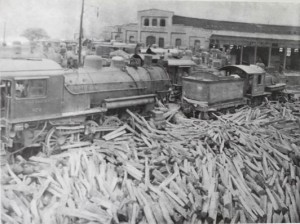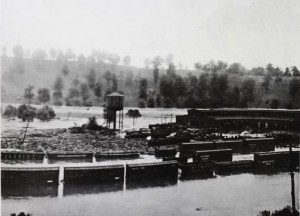
Map of the Southern Railway Showing Lines Affected by Flood of 1916.
From: The floods of July 1916: How the Southern Railway Organization Met an Emergency.
According to thorough accounts released by the Southern Railway Company in 1917, the flood of 1916 posed high-level threats for the sociopolitical and economic landscape of the Carolinas. In their account of the events following the flood, the Company emphasizes their role in alleviating the situation, stating that they were inextricably responsible for this level of activism because they experienced the greatest financial loss of any company or individual. The costs to damages resulting from the flood are estimated at $1,250,000.
The two most impacted lines in the Catawba river basin were at the Catawba River Bridge junction near Belmont and that near Eufola. The Belmont line accessed Charlotte and the Eufola line accessed Statesville, meaning the destruction of the bridges at these lines (which entered each city respectively) caused communication, trade and human transportation to be temporarily shut down. This had a large impact on the operations of both cities for up to several months.
The Southern Railway Company also emphasizes the great loss of both lives and property as a product of the flood. Between tangible property, crops, livestock, farm property, suspension of business, railroads, bridges, trestles and culverts, the company estimated $21,724,085 lost due to the flood. In terms of human life, at the Belmont bridge outside of Charlotte, ninety people went down with the bridge and were lost.
The report issued by the Southern Railway Company in 1917 reveals a great sense of urgency and fear within the region surrounding the possibility of life-incidents in the future. The rhetoric used to explain the events proceeding the flood reveals a great deal of pride in the Company’s ability to respond and act as heroic agents of society. The writing implies a strong desire to improve flood controls and prevent such negative impacts by researching methods such as successful damming.


Speak Your Mind